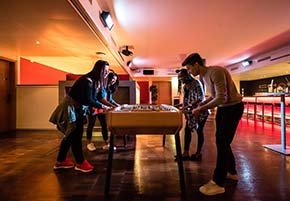- About
- Programs
- Innovation & Research
- Campus Life
- Career Services
- Admissions
- News & Events
- Alumni
Wine Pairing Guide: How to Match Wine with Food
Discover the best wine pairings for your favorite dishes. Learn how to match red, white, and sparkling wines with food for a perfect dining experience.
Key Takeaways
- Acidity, tannins, sweetness, and body of the wine are all crucial elements in successful wine pairing.
- Some common mistakes include overpowering flavors, ignoring balance, and relying solely on wine color.
- Wine pairing can be approached through congruent pairing, which matches similar flavors, or contrasting pairing, which balances opposites to create harmony.
Wine pairing has become more than just a long tradition; it is now a science and an art that can improve your dining experience. Finding the perfect balance between the flavors of a dish and the characteristics of a wine are key elements of wine pairing.
When done correctly, a well-matched wine can improve the taste of a meal and create a combination of flavors that delight your palate. Whether you’re hosting a dinner party or thinking of becoming a sommelier, the basics of wine pairing can change your culinary experiences.
Understanding Wine Pairing Basics
Understanding and mastering wine pairing requires key elements that affect how wine interacts with food. These elements can include:
- Acidity: Wines with higher acidity, like Sauvignon Blanc or Chianti, can cut through fatty dishes, cleansing your palate and balancing flavors.
- Tannins: Tannins are primarily found in red wines and create a drying sensation in the mouth. They can pair well with foods rich in protein, such as steaks, and make the wine feel smoother on your palate.
- Sweetness: Sweet wines like Riesling or Moscato can help spicy or salty dishes create a more harmonious contrast.
- Body: The weight of a wine (light, medium, or full-bodied) should match the richness of the dish. For example, a heavy stew is better paired with a full-bodied Cabernet Sauvignon rather than a light Pinot Grigio.
Are you wondering where to start your dream hospitality career? Look no further than a bachelor’s degree at César Ritz Colleges Switzerland.
Wine pairing methods
Wine pairing can be done in two primary methods:
- Congruent Pairing: This approach focuses on pairing similar flavors and characteristics. For example, pairing a buttery Chardonnay with a creamy pasta dish, since both have a smooth texture.
- Contrasting Pairing: This approach focuses on pairing opposites. The richness of fried foods can be contrasted with a crisp, acidic wine, such as Champagne, which creates a refreshing balance between saltiness and acidity.
Best Wine Pairings with Food
The ideal wine pairing does more than just complement your meal—it elevates the flavors, enhancing each bite. Understanding the best pairings for red, white, sparkling, and dessert wines can help you create flavorful combinations.
Red wine pairings
Red wines are popular for their bold flavors, tannins, and structure, which makes them perfect for pairing with rich, hearty, and umami-heavy food. Red wine pairings are as follows:
- Cabernet Sauvignon: As a full-bodied wine, Cabernet Sauvignon pairs tastefully with grilled red meats, eggplant parmesan, smoked tofu, lamb, and aged cheese.
- Merlot: Softer than Cabernet, Merlot works beautifully with roasted poultry, grilled steak, mushroom risotto, pecking duck, and tomato-based pasta.
- Pinot Noir: With its lighter body and acidity, Pinot Noir can ideally pair with seafood like shrimp, lobster dishes, scallops, flaky tuna, salmon, and trout. Pinot can make a great match for both meat and fish.
- Malbec: Malbec’s distinctive dark fruit flavors and smoky undertones complement spicy foods, barbecued meats, and cheeses like asiago or cheddar.
White wine pairings
White wines are lighter in tannins and more acidic in flavor, making them perfect for pairing with fresh and lighter dishes. White wine types and specific foods that can pair well include:
- Chardonnay: Chardonnay can complement creamy sauces, roast chicken, and lobster. Seafood can also pair well with lighter, unoaked Chardonnay.
- Sauvignon Blanc: Sauvignon Blanc is a good match for goat cheese, salads, and seafood as it is high in acidity.
- Riesling: Depending on the dryness or sweetness of the wine, Riesling can pair great with spicy Asian cuisine or fruit-based desserts.
- Pinot Grigio: Light appetizers, seafood, and salads can perfectly hold up with light Pinot Grigio.
- Gewürztraminer: This aromatic wine can pair elegantly with spicy dishes, smoked meats, and strong cheeses.
Sparkling wine pairings
Sparkling wines combine with various foods as they have high acidity and fizziness. Different types of sparkling wine combine well with foods like:
- Champagne: As the ultimate drink for celebrations, Champagne can be paired with oysters, fried foods, and light appetizers.
- Prosecco: An Italian sparkling wine like Prosecco is ideal for seafood, light pasta dishes, and fruit-based desserts.
- Cava: As a Spanish sparkling wine, Cava complements tapas, fried foods, and creamy cheeses.
- Rosé Sparkling Wine: With fruity and floral notes, rosé sparkling wine compliments charcuterie, salads, and lighter desserts.
Dessert wine pairings
With their natural sweetness, dessert wines are best paired with cheese and desserts.
- Port: As a rich and mellow wine, Port can pair wonderfully with chocolate, blue cheese, nuts, or desserts like crème brûlée.
- Sauternes: A French dessert wine like Sauternes can be perfect for fruit tarts like caramelized apple tart, foie gras, or grapes.
- Moscato d’Asti: With its lightness and sweetness, Moscato d’Asti pairs well with fruit salads, light cakes, almond cookies, dried fruits, and soft cheeses.
- Ice Wine (Eiswein): As a wine made from frozen grapes, ice wine can hold up well with rich desserts like panna cotta or cheesecakes.
Common Wine Pairing Mistakes to Avoid
Even with careful planning, wine pairing doesn’t always turn out as expected. Here are some common missteps to be mindful of and how to avoid them:
Overpowering flavors
A well-balanced pairing enhances both the food and the wine, but sometimes one element can overshadow the other. Here are a few situations to watch out for:
- Pairing a full-bodied red wine with light dishes: A bold wine like Pinot Noir or Cabernet Sauvignon overpowers delicate dishes like grilled fish, making it difficult to appreciate their subtle flavors.
- Choosing extremely acidic wines for mild foods: Wines with high acidity, such as Sauvignon Blanc, transform the taste of mild or lightly seasoned dishes into a bland or metallic taste.
- Serving a dessert sweeter than the wine: If the dessert is sweeter than the wine you’re pairing it with, it loses its taste. Instead of tasting fruity or complex, it leaves you with a flat, dull, or bitter taste.
Ignoring balance and contrast
Achieving harmony between wine and food is key to an enjoyable pairing. However, overlooking the balance between harmony and contrast can lead to less-than-ideal combinations. Some common mistakes to avoid include:
- Pairing rich, heavy food with an equally heavy wine: A creamy pasta dish paired with a full-bodied Cabernet Sauvignon can create an overwhelming experience, leaving your palate fatigued rather than satisfied.
- Serving delicate food with a bold wine: Light and flaky fish, for example, struggles to stand up to a powerful Shiraz. The wine’s intensity can overshadow the dish’s subtle flavors rather than improve them.
- Lack of contrast where needed: Without a touch of contrast, pairings can fall flat. For example, a buttery Chardonnay paired with buttery lobster results in a one-dimensional experience rather than a dynamic pairing.
- Creating too much contrast: While contrast can enhance a pairing, extremes can lead to imbalance. Pairing a sweet dessert wine with a highly salty or savory dish creates a clash, leaving the flavors competing rather than complementing each other.
Pairing wine solely based on color
For years, the belief that “red wines are meant for red meat and white wines for lighter fish” has been the primary guide for pairing wine and food. While this can be a helpful starting point, it’s just one factor in creating a great pairing.
Wine pairing is about more than just color—it’s the wine’s acidity, tannins, sweetness, and body that truly determine how well it complements a dish. You can find ideal pairings for your tastebuds by following these examples:
- Light-bodied red wines: A Pinot Noir pairs well with salmon or roasted chicken as a result of its subtle tannins and bright acidity.
- Full-bodied white wines: A full-bodied or oaked Chardonnay holds up well with creamy pasta since its weight and texture complement the food’s flavors.
- High-acidity white wines: A Riesling with high acidity balances the heat of spicy foods or fried chicken.
Master the Art of Wine Pairing
Wine pairing is a skill that requires knowledge of wines, intuition, and a desire to experiment. If you understand the basics of acidity, tannins, sweetness, and body, you can create tasteful dining experiences. However, during your experiments, avoid common mistakes like overpowering flavors, ignoring balance and contrast, or relying solely on color.
If you’re passionate about wine and eager to expand your expertise, consider exploring the Wine Business Management Program at César Ritz Colleges to build a future on your passion. Enhance your palate while gaining valuable industry knowledge. Apply today and take the first step toward a successful future as a sommelier!
Frequently Asked Questions
How does wine aging impact food pairing?
Aged wines can develop more complex flavors like earthy or nutty notes, which can pair well with savory dishes. However, older wines may lose some of their acidity, which can make them less suitable for highly acidic foods.
What’s the best way to store leftover wine for future pairings?
One of the best ways to store leftover wine is to transfer it into a smaller container to protect it from oxidation. You can also use a wine stopper or vacuum pump to remove air from the bottle and store it in the refrigerator. Red wine can be enjoyed within 3-5 days, while whites and sparkling wines can be consumed within 1-3 days.
Are you wondering where to start your dream hospitality career? Look no further than a bachelor’s degree at César Ritz Colleges Switzerland.



















